Custom Shop: Skjold Design Guitars
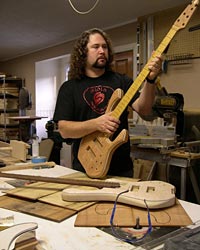 Pete Skjold had been playing bass for several years when he realized that to get what he wanted, he would have to design it himself. Eleven years after his first design, he began building full-time under the moniker Skjold Design Guitars, producing around 35 handmade basses annually.
Pete Skjold had been playing bass for several years when he realized that to get what he wanted, he would have to design it himself. Eleven years after his first design, he began building full-time under the moniker Skjold Design Guitars, producing around 35 handmade basses annually.
A bass enthusiast to the core, we first caught up with Skjold at the Gerald Veasley Bass Boot Camp, where he taught a class and talked with just about everyone. We recently got to catch up with him again to get his story and opinions on the bass.
How did you get your start building basses?
I have been playing bass since 1987, which led me on a quest. I was playing Tobias basses and was wanting to move to a six string. In 1990 Tobias Guitars was sold to Gibson, which left me searching for a replacement. I started designing basses in 1992 when I met a luthier named Chris Pearne in New Hampshire. This bass became my Standard ’92 design.
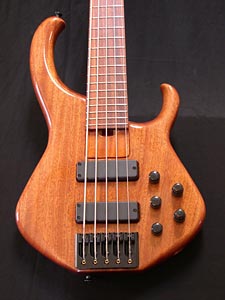 After moving to Las Vegas in 1994, I showed the bass around to several players who really liked it. This got me thinking in terms of producing an instrument under my own name. I was originally going to have other luthiers build them for me since I had no idea as to how it was done. I came to the realization that it was going to be very costly, and I was going to have to do it myself if I wanted to keep the price down and keep the quality up. So in 1996 I started building the bodies. I had the necks for two basses built for me, but both of them had faulty truss rods, so I had to begin making necks too. It is hard to believe that the standard 92 will be twenty years old next year!
After moving to Las Vegas in 1994, I showed the bass around to several players who really liked it. This got me thinking in terms of producing an instrument under my own name. I was originally going to have other luthiers build them for me since I had no idea as to how it was done. I came to the realization that it was going to be very costly, and I was going to have to do it myself if I wanted to keep the price down and keep the quality up. So in 1996 I started building the bodies. I had the necks for two basses built for me, but both of them had faulty truss rods, so I had to begin making necks too. It is hard to believe that the standard 92 will be twenty years old next year!
What is the concept behind your designs?
The concept is to have a comfortable bass that is designed to balance well. Weight is also a consideration for the professional who has to hold the bass for several hours on a gig. I also strive for flexibility and versatility in the tone department. I want the player to be able to get the tones he or she is wanting for any particular situation. That is why I use East preamps and my own custom designed pickups. They allow a lot of ability to reach specific tonal goals. One major objective though is to make a bass that sounds great passively before any preamp is applied. This way the preamp compliments the tone and works with the bass.
Besides building, you are a professional player. What styles do you gravitate to, and how do you think that affects your basses?
Being a professional player for many years, I was always trying to be as versatile as possible both in terms of my playing styles and the tones I could get to match the situation. I have played a full range of styles from country, rock, blues, old-school funk and R&B (soul) and jazz. This has all directly affected my design and build goals as I strive to build a bass that can handle all of these styles convincingly. Having that first hand experience has been my greatest asset as a builder.
You seem to be pretty available to anybody, via forums, email, etc. What is it about the bass community that keeps you engaged?
I love the bass guitar!! I love the music, the players and the sense of community that bass players enjoy. This is a great time to be part of all of it. This is something I truly enjoy doing and feel very fortunate to do so. The fact that other players care about what you have to offer just makes it that much better.

Tell us about your process in creating an instrument for someone.
The process begins with finding out what the customer needs tonally. This gives us an idea of the tone woods we will be selecting. We then select pickup and preamps according to that.
After we have got all that in place we select top woods and other options based on the aesthetics the customer is after. This is usually done via emailed pictures of topwoods and fingerboards for the customer to choose from.
Finding out what the customer really needs and wants is what it is all about so this can be a involved process at times but it is worth it!
What is your opinion of bolt-on versus neck-thru construction?
I use bolt-on exclusively because as a player who only played neck-through basses in the beginning, I realized there were certain tones or types of tones I couldn’t get on neck-throughs. Because I wanted super versatile basses, that is the path I have gone down. There is nothing wrong with a neck-through bass of course, it just does certain things tonally which make it less flexible at times. It can be very hard to get a scooped tone on a NT bass because the NT design accentuates the midrange quite a bit, which usually means you get a great fingerstyle tone but slapping can be difficult. The high-end is also different on NT basses because of this. I have found that you can still get that great fingerstyle tone on a bolt-on bass if it is made properly and they can be EQ-ed to a greater extent and still sound natural. One misnomer is that a bolt-on is inferior to a neck-through as a rule. This simply isn’t the case.
How did you hook up with John East to design the electronics for your instruments?
I was made aware of John East in early 2004 and right away was impressed by the versatility (there’s that word again!) that his preamps were capable of producing. We have since worked closely to develop and customize preamps for my basses. I now have four unique preamps from John East which further enhances my ability to tailor the basses to the customer. He is a great asset.
What is your opinion of active versus passive pickups?
Active pickups and passive pickups are fine, depending on what you are going for tonally. Active pickups generally are a low impedance, which make them lower output with a broader range of frequencies. Because of the lower volume you typically need to add a gain stage and buffer to them so you can bring up the output. When I first designed my basses back in 1992, I was made aware of Lane Poor and his pickups. They were basically passive pickups but worked best with a gain stage buffer, which then made them active. You could do this with any pickup. Typically passive pickups use stronger magnets and more winds to achieve output, but this does impact the tone of the pickup by enhancing usually the midrange and then the top end and low end of the tone. It is important to know what the passive pickup is giving you tone-wise when building a bass so it does work against the natural tone of the bass. At the end of the day either design is totally valid if it gives you the results you want when combined with the electronics and the natural tone of the bass.
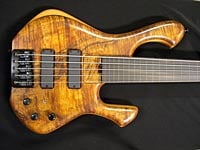
What is your favorite part about building basses?
I guess my favorite part is when the customer receives the bass and is really happy with it. That makes the whole process worth it. I also really enjoy selecting the woods and the finishing process. Plugging the bass in for the very first time is also a unique experience all it’s own. I am very fortunate to say that the whole experience of building a bass is still a very gratifying one.
How many basses have you built to date?
I have built around 250 basses, not including the batch I have now which is 30-plus and growing. I started building full time in late 2003, and for the first three years I did small batches as I was still refining and developing my processes. Since 2007 I’ve put out an average of 35 basses annually. I am a one man operation, and I dedicate a good portion of time to each individual customer, so this factors in. I continue to refine my processes and have acquired new tools that should allow me to push my output up into 45-50 basses annually.
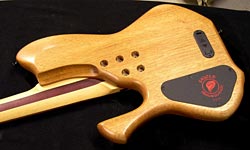
How do the more recent ones compare with the first?
The most recent basses have been refined as much as possible in terms of consistency and efficiency. The first ones varied a bit from batch to batch, because I also had a partner doing many of the processes up until the middle of 2005. After he left, I spent much of 2006 just standardizing my methods. With any good builder, you should see a noticeable difference in the earlier work to the present, and I have always admired the builders who have made to biggest strides in the shortest time. With every batch I try to improve upon something. I am finally at a place where that is getting harder and harder to do.
What’s the craziest thing you’ve been asked to incorporate in one of your basses?
Wow, this is a hard one. I get some strange requests from time to time, but one thing I had a request for that was definitely unique was a bottle opener. It actually worked quite well in the end.
What would you tell someone thinking of building his or her own bass?
I would say go for it, but be careful, it is addictive!! Haha!! You might find yourself wondering where twenty years went!
For more, visit the Skjold Design Guitars website.

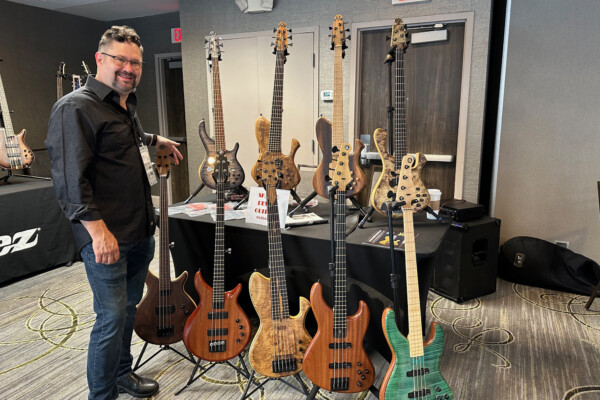
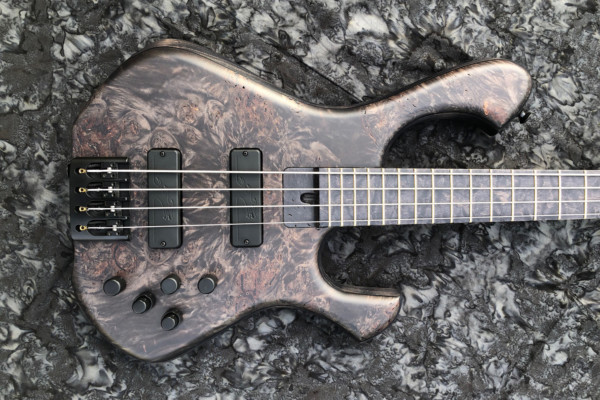
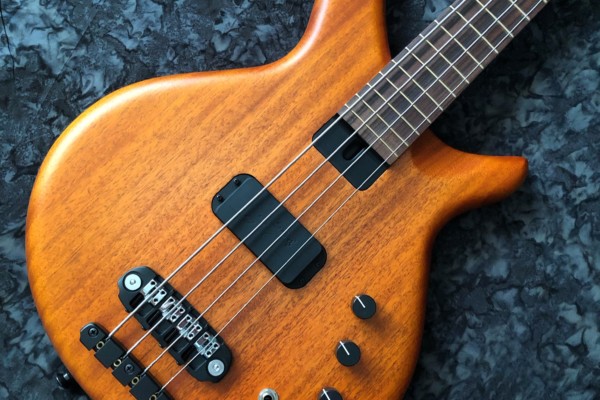
A few of my friends have been telling me lately that I need to get into building basses and guitars. I just wouldn’t know where to begin, but it is WAY intriguing. I’m tempted.